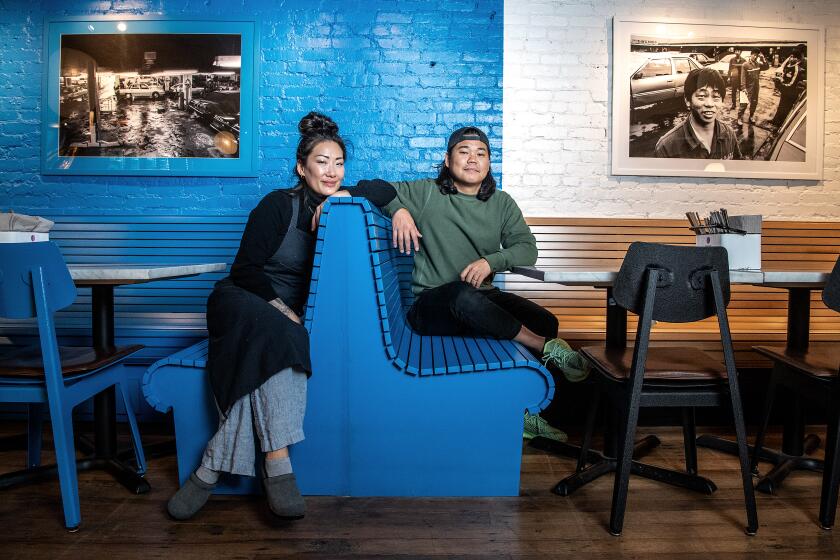Barrio Fiesta Imports Taste of Philippines
- Share via
It’s odd that Filipino food is so little known in California. Of all Asian cuisines, this is the one most likely to tempt people who balk at anything exotic. With its overlay of Spanish and American influences, Philippine cuisine is the most Westernized and mildly seasoned in Southeast Asia. Think of fried chicken and French fries, barbecued pork, fruit salad and flan. Chinese additions include lumpia, pancit and sinangag. Exotic? Don’t worry. They translate to egg rolls, noodles and fried rice, familiar to most American palates.
According to the 1980 United States census, Filipinos are the largest Asian ethnic group in California. Yet there is a dearth of Filipino restaurants in Los Angeles. Even worse, a couple that opened recently produced awful stuff. That makes the arrival of the Barrio Fiesta seem like a miracle. The food is wonderful, despite an occasional lapse. And the restaurant is airy and tropical, as if it had been transported straight from Manila.
As a matter of fact it was, right down to the pale floor of narra wood (Philippine mahogany) inset with tiles. The bamboo arbor overhead, the wicker chairs, the little wicker carts that hold fresh flowers and the shell-bedecked lamp shades are other imports. Beige and peach tones make the restaurant glow. And there is pretty music in the background--the strumming of a rondalla or romantic songs of the Philippines.
The Barrio Fiesta is about to double in size, a good thing because it is consistently jammed. Good food, large servings and low prices are the main lure. An established reputation also helped. Manila has several Barrio Fiestas, owned by members of the same family. Corazon Ongpauco Tamayo and her husband, Manuel, who have the Greenhills branch, opened this one.
Cooks From Philippines
The kitchen is staffed by cooks brought from the Philippines, and Corazon Tamayo makes some of the desserts herself, among them flan (be sure to have it with the coconut preserves called macapuno) and halayang ube, a sweet paste made from a purple yam that grows in the Philippines.
On a first visit, try familiar-tasting dishes such as fried chicken and barbecued pork. The chicken is superb. There is no great trick to it, just good seasoning and no clumpy breading. The pork, strung on skewers like satay, has a luscious sweet glaze. Don’t confuse it with the barbecued pork chop meat, which is drier and tastes more of charcoal.
Bulalo steak may sound immensely foreign, but the meat is like grandmother’s pot roast. It comes sliced and stacked on a bulbous knuckle bone, which yields the marrow (bulalo) that Filipinos regard as a treat. (Testifying to that, the marrow disappeared from my helping before it reached the table.)
The menu is riddled with Tagalog and Spanish terms. However, a Spanish dictionary will be of little help. Here, tocino is not bacon, as the dictionary says, but specially cured bits of pork that taste sweet and crispy. The meat is succulent, but frying makes it rather oily. And lechon kawali-- deep-fried belly pork--is downright fatty.
House Specialty
In the Philippines, tasty fat is highly regarded. In the United States, health concerns make it a detriment. But damn the cholesterol and full speed ahead when the approaching dish is crispy pata. The crisp skin and tender, juicy meat clinging to the deep-fried, knobby bones are irresistible. It’s a house specialty and possibly the most popular dish at the restaurant.
Another specialty is kare kare, an oxtail stew. Vibrantly yellow, like a zesty Thai or Indian curry, the sauce promises exciting flavor. Sadly, it had none, except for a faint hint of peanuts, and my bowlful was barely lukewarm. Furthermore, I received a utilitarian white bowl, not the quaint earthen pot on a warming stand that usually holds this dish.
That was the low point of my visits to the Barrio Fiesta. The high point was the extraordinary Filipino dessert called halo halo. The name means “mix mix.” And what else could you call a kaleidoscopic assortment of sweetened beans, young coconut shreds, jackfruit, palm seeds, purple ube paste, flan, ice cream, milk, crushed ice and crispy roasted rice, which is called pinipig. The notorious halo halo of the Peninsula Hotel in Manila comes in an enormous brandy snifter. I worked at that one for an hour and couldn’t finish. The Barrio Fiesta’s is the best I’ve had since, not as large, to be sure, but creamy, rich and wonderfully satisfying.
Barrio Fiesta, 3821 W. Sixth Street, Los Angeles (in a shopping center); (213) 383-9762. Open from 11 a.m. to 9:30 p.m. Monday, Wednesday and Thursday; to 10 p.m. Friday through Sunday. Closed Tuesday. No reservations. MasterCard and Visa accepted. Free parking in shopping center lot.
More to Read
Eat your way across L.A.
Get our weekly Tasting Notes newsletter for reviews, news and more.
You may occasionally receive promotional content from the Los Angeles Times.









